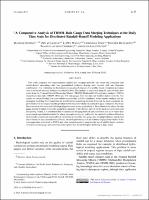| dc.contributor.author | Nerini, D. | |
| dc.contributor.author | Zulkafli, Z. | |
| dc.contributor.author | Wang, L.-P. | |
| dc.contributor.author | Onof, C. | |
| dc.contributor.author | Buytaert, W. | |
| dc.contributor.author | Lavado-Casimiro, W. | |
| dc.contributor.author | Guyot, J.L. | |
| dc.date.accessioned | 2019-07-22T14:39:59Z | |
| dc.date.available | 2019-07-22T14:39:59Z | |
| dc.date.issued | 2015-01 | |
| dc.identifier.uri | https://hdl.handle.net/20.500.12542/57 | |
| dc.description.abstract | This study compares two nonparametric rainfall data merging methods-the mean bias correction and double-kernel smoothing-with two geostatistical methods-kriging with external drift and Bayesian combination-for optimizing the hydrometeorological performance of a satellite-based precipitation product over a mesoscale tropical Andean watershed in Peru. The analysis is conducted using 11 years of daily time series from the Tropical Rainfall Measuring Mission (TRMM) Multisatellite Precipitation Analysis (TMPA) research product (also TRMM 3B42) and 173 rain gauges from the national weather station network. The results are assessed using 1) a cross-validation procedure and 2) a catchment water balance analysis and hydrological modeling. It is found that the double-kernel smoothing method delivered the most consistent improvement over the original satellite product in both the cross-validation and hydrological evaluation. The mean bias correction also improved hydrological performance scores, particularly at the subbasin scale where the rain gauge density is higher. Given the spatial heterogeneity of the climate, the size of the modeled catchment, and the sparsity of data, it is concluded that nonparametric merging methods can perform as well as or better than more complex geostatistical methods, whose assumptions may not hold under the studied conditions. Based on these results, a systematic approach to the selection of a satellite-rain gauge data merging technique is proposed that is based on data characteristics. Finally, the underperformance of an ordinary kriging interpolation of the rain gauge data, compared to TMPA and other merged products, supports the use of satellite-based products over gridded rain gauge products that utilize sparse data for hydrological modeling at large scales. | en_US |
| dc.format | application/pdf | |
| dc.language.iso | eng | en_US |
| dc.publisher | American Meteorological Society | en_US |
| dc.relation.ispartof | urn:issn:1525-755X | |
| dc.relation.uri | https://journals.ametsoc.org/view/journals/hydr/16/5/jhm-d-14-0197_1.xml | |
| dc.rights | info:eu-repo/semantics/openAccess | |
| dc.rights.uri | http://creativecommons.org/licenses/by-nc-sa/3.0/us/ | * |
| dc.rights.uri | Atribución-NoComercial-SinDerivadas 3.0 Estados Unidos de América | * |
| dc.source | Servicio Nacional de Meteorología e Hidrología del Perú | es_PE |
| dc.source | Repositorio Institucional - SENAMHI | es_PE |
| dc.subject | Amazonia | es_PE |
| dc.subject | Hydrologic models | en_US |
| dc.subject | Precipitación | en_US |
| dc.subject | Satellite observations | en_US |
| dc.subject | Statistical techniques | en_US |
| dc.subject | Surface observations | en_US |
| dc.title | A comparative analysis of TRMM-rain gauge data merging techniques at the daily time scale for distributed rainfall-runoff modeling applications | en_US |
| dc.type | info:eu-repo/semantics/article | en_US |
| dc.identifier.isni | 0000 0001 0746 0446 | |
| dc.description.peerreview | Por pares | |
| dc.identifier.doi | https://doi.org/10.1175/JHM-D-14-0197.1 | |
| dc.source.volume | 16 | |
| dc.source.issue | 5 | en_US |
| dc.source.initialpage | 2153 | en_US |
| dc.source.endpage | 2168 | en_US |
| dc.source.journal | Journal of Hydrometeorology | en_US |
| dc.subject.sinia | precipitacion - Clima y Eventos Naturales | |
| dc.type.sinia | text/publicacion cientifica | |
| dc.identifier.url | https://hdl.handle.net/20.500.12542/57 | |








